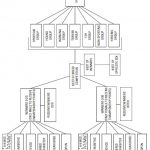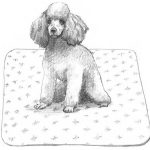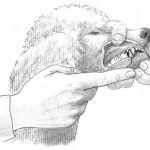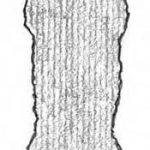Preparing for Your Poodle’s Homecoming
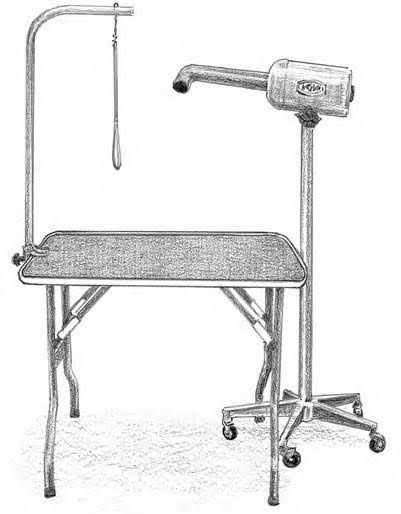
In This Chapter
- Shopping for your Poodle’s everyday necessities
- Ensuring that your home is safe for (and from) your Poodle
- Setting up your Poodle’s special spots
- Making an appointment with a vet
Bringing home a Poodle is like bringing home a new baby, minus the diapers. You need to make your home safe and to shop for dog beds, toys, dishes, and more. The information in this chapter makes it easy to prepare your home before your Poodle arrives.
Tip
The easiest way to shop for supplies is one-stop shopping at a large pet-supply store, but if you’re not buying everything at once, you have other options. Most supermarkets and discount stores have food and water bowls; some have beds and crates as well. The same goes for dog toys, collars, and leads. You can check out online sites for supplies, too, and dog catalogs sell anything and everything.
Outfitting Your Home with Crates, Gates, and Ex-pens
Crates
– He sees a cozy and safe place he can turn to.
– He can face the opening to observe what’s going on without worrying about anything approaching him from the back, sides, or top.
– A crate offers a draft-free place to sleep.
– In cooler weather, the crate helps contain his body heat.
Warning!
Unfortunately, many people misuse crates. A crate should be a temporary quarters, not a permanent home. Crate your Poodle only when you need him temporarily out of the way. You can crate for a few hours when you need to go out (ideally, for no more than four to six hours at a stretch). You also can crate for the night. However, if you plan to routinely leave your dog crated for 8 to 10 hours a day while you work, with no one to give him a break, you should rethink your decision to get a dog.
The benefits of crates to owners
– Crates make housetraining easy. Dogs don’t like to go to the bathroom where they sleep. (See Chapter Keeping Your Poodle Clean and Attractive for more about housetraining.)
– A crate provides a safe place for your Poodle when you can’t watch him. Crates get your Poodle out of the way when you have company. You also don’t have to worry about someone stepping on your Poodle or giving him a forbidden food. When you leave the house, your Poodle can curl up with a toy; you’ll know that he’s safe and not gnawing on an electric cord.
– In the car, a crate keeps your Poodle in one spot — not under the brake pedal, in your lap, or hanging out the window. In case of an accident, your Poodle won’t fly into the windshield or escape through a door into traffic. (Head to Chapter Hitting the Road with Your Poodle for more about traveling with your Poodle.)
– People who might not otherwise want you to bring your Poodle to visit may allow it if he’s crated. Crating your Poodle in a motel room ensures that he won’t cause you to get a bill for damages.
Types of crates
Remember
Crates come in two basic styles: solid plastic and wire. A third, lesscommon style is a soft mesh crate. Figure 5-1 shows these styles; the following list presents the differences between the three types:
– A plastic crate seems more like a den to your Poodle and will protect him against drafts and keep him warmer. If you plan to fly with your Poodle, and he’ll be in cargo, not in the plane’s cabin, you need the solid plastic type of crate. Plastic crates are the safest way for your dog to travel in a vehicle. A disadvantage is that they hold in more heat in summer.
– A wire crate allows for more ventilation in summer. A wire crate will most likely have a removable bottom tray, which can make cleanup easier. Also, many wire crates come with a wire panel that makes the crates smaller for puppies; you can remove the panel when the dog is full-grown. The downside of a wire crate is that it never seems very snug to your Poodle.
Tip
If you choose a wire crate, consider buying a special crate cover or covering the top and sides of the crate with a blanket or towel. In the summer, you can flip the sides up on a wire crate to allow more air to reach your Poodle.
– A mesh crate is an option for frequent travelers. This crate is lightweight and folds compactly; is easy to pack and carry; and allows for quick setup in a motel room. Many dogs do well with these in the short term. People who compete with their dogs in various events find them easy to carry, and they offer good ventilation. They aren’t recommended for car travel, though, because they don’t offer any protection, and they aren’t the best for puppies or for long-term crating, as dogs may try (and succeed) to chew their way out. Also, the bottoms are mesh, so they offer no solid barrier should a puppy have an accident.
Tip
If you have a Toy or Miniature Poodle, and you plan to fly with your dog in the cabin, you may consider several brands of carriers designed specifically to fit beneath an airline seat.
Remember
A crate must be big enough for your dog to stand up and turn around comfortably. It may make sense to your pocketbook to buy the crate your Poodle will need as an adult, but going that route can make housetraining harder. No dog wants to go to the bathroom where he sleeps, but a crate that’s too big may make it possible for him to have a cozy bed at one end and a bathroom at the other. I recommend that you buy or borrow a puppy-sized crate when you first get your Poodle and plan to buy a larger crate later, or buy an adult-sized crate now and insert a divider.
Gates
– Metal: Metal gates are sturdy and less apt to be destroyed.
– Wood: Wood looks nicer and may blend better with your furnishings, but puppies may find a wood gate the perfect teething tool.
– Mesh: Mesh is generally cheaper, but that also means that it’s easier for a dog to destroy.
Remember
Most dog-supply stores and catalogs should sell baby gates. Or, you can use a gate made for human babies. You can assemble and break down many types of gates with no tools and no attachments to a doorjamb. Some gates are more permanent; you can open and close them instead of having to step over them. You can even find some gates made for wider or irregular-shaped openings. Prices can run from $30 to $130, depending on the model you need.
– If you plan to keep certain rooms off-limits when your Poodle puppy reaches adulthood, make sure you buy gates high enough to keep an adult Poodle from jumping over.
– Consider the material the gate is made of, as I describe earlier.
– Consider the size of the gaps between the bars, if the gate has any. Make sure your Poodle can’t get his head stuck in a gap. Getting stuck could just frighten your Poodle, or it could cause serious injury. Even small gaps can trap a puppy who’s determined to shove through an opening.
Ex-pens
Tip
An exercise pen, or an ex-pen, is a playpen for your Poodle. An expen isn’t a necessity, but it can be a useful piece of equipment. If you want to corral your Poodle in a small part of the yard, an expen is the way to go. It gives your dog more freedom than a lead, but it still limits where he can roam. You also can use an ex-pen indoors. It can act as a gate across a large opening, or you can use it to fence off part of a room for housetraining purposes, if crate training isn’t practical for you (see Chapter Keeping Your Poodle Clean and Attractive for more on training). Most ex-pens run between $40 and $90.
Buying Comfortable Bedding
Remember
Whatever you choose, though, you may want to wait until your Poodle becomes an adult before you buy his “good” bed. Why do I say that? Because puppies have accidents and puppies chew. A puppy can chew an expensive bed to pieces faster than you can imagine. Housetraining is another consideration. Most good beds have some kind of padding that makes them warm and comfy for your dog. If your puppy has an accident, it can take two or three days for the “stuffing” to dry.
Tip
To keep your Poodle comfortable, make him a bed of old bath towels and some synthetic fleece. Both items are renewable and inexpensive, and you can machine wash and dry them quickly. For untrained puppies, make a nest of shredded paper. They can burrow into the paper for warmth, but there won’t be the danger of them chewing and swallowing fabric chunks, which can cause intestinal blockage.
– You can find basic crate pads if you want to keep it simple.
– You can buy bumper pads to cushion the sides of wire crates.
– Some beds are made to fit the corner of a room.
– Some beds have bolster edges to them for dogs who like to sleep with their heads on pillows.
Tip
No matter what style bed you buy, you should get one that has a removable cover so that you can launder it regularly without having to wash and dry the filling.
Staying Attached with Collars and Leads
Shopping for collars
Remember
When your Poodle enters adulthood (around one year of age), you can consider any of the following collars (see Figure 5-3 for a sampling):
– Flat buckle collars: Typically, these collars are made of leather or nylon. Fancy ones may be made of velvet, decorated with rhinestones.
– Martingale collars: These join the larger collar with a smaller loop that connects the ends of the larger part. Martingale collars can be tightened, but only to the size of the larger loop. You also can find Martingale collars that have a section that pulls out and acts as a handle. The advantage of these collars is that they can’t choke your dog, yet they’ll tighten so that the dog can’t pull out of the collar. You can’t leave a Martingale collar on all the time because the smaller loop can easily snag on things, or a dog can catch a leg in it and be injured.
– Prong collars: These collars have metal prongs that face inward and pinch the dog’s neck when it’s tightened. They’re typically used on large, strong dogs to keep control; they’re not a “general use” collar.
– Training collars: You don’t want to get a training collar until your puppy is at least 6 months old because there is a risk of harming a younger dog whose muscles and bones are still forming.
Warning!
With the exception of a buckle collar, you should never leave any kind of collar on your Poodle when he’s unattended. Collars with attachments can catch on objects and injure or kill your dog.
Warning!
But don’t use a regular walking harness with a car seatbelt. This type of harness isn’t strong enough to restrain a dog in an accident. Use only a harness specifically designed for car travel, and make sure that it’s correctly adjusted to the dog and fastened to the seatbelt. Figure 5-4 shows this setup.
Warning!
I recommend collars over harnesses for walking around. A harness gives you no control over your Poodle and makes it easier for your dog to pull you down the street during a walk. If you’re training your Poodle for a competitive event like tracking, weight pulling, skijoring, or sled pulling, get a harness appropriate for that specific activity. Otherwise, stick with a collar.
Looking at leads
– Length: A six-foot lead is a good length, no matter the Poodle’s age.
– Weight: Buy a weight that suits the Poodle you have. Heavier isn’t necessarily better, but a quarter-inch-wide nylon lead that restrains your puppy may be too light for a Standard Poodle. A lead of 3⁄4 inch is nice for a Standard and not too bulky to hold.
– Material and color: You can purchase nylon leads in assorted colors, which frequently have matching collars. You also may find leads made of cotton, and leather is always a good choice. I like leather because it’s flexible and feels good in my hand when I take my dogs for walks. It also lasts a long time.
Warning!
Avoid plastic leads, which have a tendency to crack and break. You also should avoid chain leads. The only way to hold a chain lead comfortably is by grabbing the loop at the end, and many times you need to actually grab the lead itself. Grabbing a chain is uncomfortable, and if your Poodle happens to lunge forward, he’ll pull the chain across your hand. Hello, first-aid kit!
Warning!
If you opt for a retractable lead, make sure you know your surroundings, and be careful. If you’re crossing the street with your Poodle ahead of you by 15 feet or so, you’re putting your dog in danger of being hit by a car.
Securing Proper ID for Your Poodle
Remember
It doesn’t matter how carefully you watch your Poodle, accidents can happen. You may not latch a gate properly, or you may leave a door open a second too long. Bang! Your Poodle is on the loose. You can do your part to help him get back home by outfitting him with proper identification. Your options include the following:
– Have a tag made for your Poodle’s collar that features your phone number and any other information you may want to include. The tag is visible and easy to use. One drawback is that a collar can come off or be removed if someone steals your dog (a worst-case scenario). Most veterinarian offices sell them, as well as animal shelters. Dog shows and carnivals frequently have booths that make up tags as you wait. Tags generally cost less than $5.
– Get your Poodle some ink. Some breeders tattoo all their puppies for ID purposes. If yours didn’t, you may choose to have your Poodle tattooed with his registration number or a phone number (a vet can tattoo your dog). Tattoos usually appear on the inner thigh or on the inside of the flap. The advantage to a tattoo is that it’s permanent; the problem with ID tattoos is that they can stretch and fade as a dog grows, and they can be covered by hair. Costs range from $25 to $55.
– Talk to your vet about getting a microchip. A microchip is a small tracking device, about the size of a grain of rice, that a vet implants between your Poodle’s shoulder blades. A scanner can read the information on the chip, which allows vets or shelter workers to contact a particular microchip’s registry. The registry, in turn, contacts you. A microchip has an advantage over other forms of ID because it will always be a part of your Poodle; it never fades, and it won’t get lost. A chip costs between $40 and $50.
Beautifying Your Poodle with the Right Grooming Tools
Hair care
Nail care
– The guillotine type, with a blade that slides across and slices the nail
– Clippers that squeeze together to cut the nail
– Clippers that have small, rounded cutting blades and that cut scissor style
Tip
An alternative to nail clipping is grinding the nails. A grinding tool (which costs between $50 and $65) has a wheel that rotates at a high speed to grind away excess nail. Many dogs that fight ordinary clipping happily (or at least willingly) accept grinding. Used frequently, grinders have the advantage of causing the “quick” of the nail to recede so that the nails can be kept shorter.
Self-grooming considerations
Savoring the Details of Food and Bowls
– Plastic bowls probably have the most variety when it comes to shapes and colors, and plastic has the advantage of being virtually unbreakable. However, it may be harder to clean plastic, and a dog can develop acne from rubbing his chin on the plastic when eating. Plastic bowls cost between $5 and $10.
– Ceramic bowls are heavy, so they prevent easy tipping when your Poodle goes to dine. Many of these bowls come in bright colors and have fun doggy designs on them. The disadvantage of a ceramic bowl is that it’s breakable. These bowls cost between $5 and $10 or, for a really fancy bowl, up to around $25.
Warning!
If you choose ceramic bowls for your Poodle, make sure the glaze on them is lead-free; otherwise, your Poodle can get lead poisoning and become ill, or even die.
– Stainless-steel bowls are unbreakable and easy to clean. Some come with rubber bases that prevent tipping, and some are made deeper and with smaller openings to help keep doggy ears from dragging through food or water. These bowls cost between $2 and $15, depending on size and whether you get a bowl with a rubber nonskid bottom.
Remember
Whatever your choice of dishes for your Poodle, make sure you wash them after every meal. Just because your Poodle polishes a food bowl with his tongue doesn’t make it clean. Wash water bowls daily, too. Wash bowls with soap and water, or put them in your dishwasher.
Getting the Scoop on Cleanup Tools
Tip
If you’re a bit squeamish about picking up your Poodle’s messes with a bag, you can purchase a small, heavy-duty cardboard cleanup kit. You use the box portion of the kit to pick up, and then you seal it and toss it. If you don’t think you can clean up after your dog at all, you should think about getting tropical fish rather than a dog. Responsible dog owners are good neighbors; they clean up after their dogs.
Finding Toys for Toys (And, Yes, Miniatures and Standards)
Following a few toy guidelines
Remember
Different dogs enjoy different toys. Your Poodle may adore stuffed toys and ignore hard rubber ones. Or maybe your Poodle is a fool for any kind of ball. Consider the following when picking out toys:
– Make sure the size of the toy fits the size of your Poodle. A ball that’s just right for a Toy, for instance, may be small enough for a Standard to swallow, and a swallowed ball can mean surgery. On the flip side, a ball that suits a Standard is no fun at all for a Toy who can’t pick it up.
– Watch your Poodle with toys. You won’t know what kind of toys work best for your dog until you try them. Experiment to find out what’s safe and fun for your Poodle.
– Consider unstuffed toys if your Poodle likes to be destructive. Manufacturers seem to be aware of the destructive powers of dogs, so many produce unstuffed toys. These toys still have squeakers, and dogs still rip them open, but at least you won’t have to contend with the stuffing.
Gnawing on chew toys
– Ropes: Thick rope toys can be both chew toys and tug toys, providing endless entertainment for your Poodle. Supervise your Poodle’s chewing so that he doesn’t swallow chunks of rope. And if you want to play tug with your Poodle, be gentle so you don’t hurt his jaw. With older dogs, stop if the game gets too rough. Some handlers advise that you never play tug with your dog, because it encourages aggression, but others say that the practice isn’t a problem if you control the game.
Tip
Teach your Poodle the “Leave it!” or “Drop it!” command with a toy like a rope. When you give the command, he must drop whatever he has in his mouth. During play, give him the command. When he drops the rope, tell him that he’s a good dog, and then offer the toy again. If the game gets too wild, stop it and move on to something else. (See Chapter Housetraining Made Easy for more about commands.)
– Food-stuffed toys: Some chew toys fall between being toys and being food. You can find several toys on the market that allow you to stuff them with food. These toys make wonderful chews for when you leave your Poodle alone. Some toys dispense bits of kibble or biscuits as your Poodle plays with them, giving him something to think about.
Warning!
– Rawhides: Dogs love rawhides, but you need to be careful with these chews. Some dogs swallow chunks of rawhide and end up with impacted bowels. Even a dog who seems to be thoroughly chewing a rawhide can end up with lumps of indigestible material in his stomach. You may be able to pinpoint this if he vomits the material. I give my dogs rawhides sparingly and usually in the form of “bones” made of shredded rawhide; this eliminates the danger of my dogs swallowing large clumps. Always supervise any rawhide treat.
Warning!
– Animal hooves: Dogs love to chew on cow hooves, but stand warned that cow hooves smell terrible and can crack your Poodle’s teeth. Swallowed chunks can cause intestinal blockage.
Rollicking with retrieving toys
Warning!
A ball that is too big is better than one that is too small. It’s easy for a dog to swallow a ball, which can end in tragedy.
Settling on squeaky toys
Getting creative with homemade toys
Tip
You don’t have to buy all your Poodle’s toys. You can utilize items around your house to make toys that your Poodle will love (under your supervision, of course). The following list presents some ideas:
– Open up a paper bag and put it on the floor. Cats aren’t the only animals that enjoy the rustle of a bag.
– Toss your Poodle the cardboard from the center of a roll of paper towels or toilet paper.
– Let your Poodle bat around a plastic milk carton. You can put a few beans or some dried corn inside so the toy makes an interesting noise. Just make sure you supervise his play.
– Give your Poodle a whole carrot and watch him play with it and gnaw on it.
– Tie multiple knots in an old sock and let your Poodle go wild. You also can stuff a tennis ball in a sock and then knot it. If your puppy is teething, wet the toy and freeze it. You also can wet and freeze an old washcloth and let your puppy chew on that.
Remember
Don’t be afraid that using a sock as a chew toy will teach a puppy that chewing on clothing is acceptable. A puppy will chew on just about anything you leave lying around, whether he’s seen the item before or not!
Poodle-Proofing Your Home
On the inside
Remember
Puppies are like toddlers: They want to put every object in their mouths, they’re faster than they look, and they get into places that seem impossible for them to enter. So, before your Poodle walks through the doors of his new home, you need to take the time to puppy-proof each room. Follow these guidelines:
– Electrical cords are real threats to your Poodle’s safety, so try to use the shortest cords possible. Tuck them behind nearby furniture, or hide them under pieces of carpeting if possible. If you have a cluster of cords, you can run them through a length of PVC pipe to keep them hidden from puppy teeth. Still, nothing works 100 percent. Supervise your Poodle when he’s around electrical cords.
– Make it a habit to keep closet doors closed, and don’t leave shoes, socks, or other articles of clothing on the floor.
– If you want certain rooms or stairways to be off-limits to your Poodle, practice keeping the doors to the rooms shut or get baby gates for the entryways (I discuss gates earlier in this chapter).
– If you have stair, landing, or balcony railings, be sure you’re your Poodle can’t get even his head through them. Building codes require them to be narrow enough to protect human infants and toddlers, but puppies are smaller. To keep your Poodle safe, cover railings with wire or fabric mesh, and supervise closely. If your Poodle is a Toy or small Miniature, you may need to leave these coverings up permanently.
– If you have rugs with fringe edges, you may want to store them away until your Poodle hits adulthood and is beyond his chewing stage. Dogs don’t mind chewing on books in a bookcase, either, so put your treasured volumes high on the shelves. Keep valuable furniture in a room that’s off-limits to your Poodle, or store it where he can’t find it.
– Keep trashcans covered or out of reach. Make sure that houseplants aren’t at puppy level so they don’t provide a salad (and some houseplants are poisonous — see “Being mindful of particular plants,” later in the chapter), and that household cleaning supplies are safely locked away.
Out in the yard
Remember
You can have a Poodle without a fenced yard, but it means never letting him off lead, unless you’re in a fenced area, like a dog park. Just like a mail carrier works in all kinds of weather, you’ll need to go out with your Poodle each and every time he goes out, though rain, snow, sleet, and gloom of night.
Examining an existing fence
Remember
If your yard is fenced and begging for you and your Poodle to use it as a playpen, give it a thorough check before your puppy arrives:
– Make sure you can’t find any gaps or holes. Dogs can wiggle through amazingly small spaces, so, when in doubt, close the gap. Depending on the hole’s location, put another piece of fencing over the hole, put a cinder block in front of it, or pull its edges together and wire it closed.
– Make sure you can’t find any sharp bits of wire or wood sticking out that could hurt your Poodle. Bend bits of wire back on itself and wrap tape around sharp points. Remove and replace jagged pieces of wood, or plane them smooth.
– Check wire fencing to see whether the openings are large enough for a puppy to get through. On the other hand, are the openings small enough to prevent a puppy from getting his head stuck? You may have to replace the fence if its openings are either too large or too small.
– Make sure the fence is tall enough. Almost any fence can keep a puppy enclosed, but when your Poodle grows up, will your fence contain him? You want to keep other dogs out as well. Four feet tall is good, and five feet is better.
– Check gaps around gates; if any of them are wide enough for your Poodle’s head, fasten stiff wire to the edge of the gate so that it will cover the opening when the gate is closed.
Putting up a new fence
– Wire: Chain link is strong and lasts a long time without much maintenance. However, you and everyone else can see through any kind of wire fence. If you have neighbors and a lot of backyard activity, will your Poodle bark at them? If a dog roams your neighbor’s yard, will he and your Poodle bark and forth? Also, children on the other side of the fence may poke objects through that you might not want your Poodle to have.
Tip
If you decide to erect a wire fence, you also may want to consider planting various bushes and shrubs along the fence line to give your yard more privacy.
– Solid fencing: This type of fencing cuts down on distractions . . . and barking. Wooden stockade fences are relatively inexpensive, but they need painting or staining regularly. PVC fencing is more expensive, but it requires little maintenance and looks very nice.
If you choose PVC fencing and want to have a gate, make sure you install the gate so that the gap between the gate and the ground is too small for your Poodle to escape.
Remember
No matter what material you choose for your fence, make sure you consider other factors besides your Poodle. For instance, the height of your fence shouldn’t be based solely on keeping your dog in. You also need to keep other dogs out. Consider installing at least a 4-foot fence. Five feet is even better, and you may even want six.
Warning!
The drawback to an electric fence is that, although it keeps your dog in, it doesn’t keep out other animals or people. Some dogs get so excited when they see animals or people that they cross the boundary in spite of the shock and then may be unwilling to cross the boundary again to return home.
Being mindful of particular plants
– Apple seeds contain cyanide, although your Poodle would have to eat an awful lot of apples to be in danger.
– Iris, tulip, and daffodil bulbs are poisonous to dogs. These bulbs are underground, though, so the risk is slight.
Remember
If your Poodle enjoys digging, monitor where he digs. Don’t leave him in the yard unattended.
– English ivy is poisonous, as are phododendron, holly, and elderberry. And don’t forget poison ivy, which is nobody’s friend!
– Oleander — its flowers, leaves, and stems — is very poisonous.
– If you have borders and you use mulch to contain weeds, avoid using cocoa mulch. It smells great, but it isn’t a good choice for dog owners. Cocoa mulch is made from cacao bean shells and contains theobromine and caffeine — the same ingredients that make chocolate harmful to a dog. If your Poodle eats cocoa mulch, he may get an upset stomach or, depending on the quantity eaten, he may become very ill.
– Mushrooms can be fatal. Remove any fungus growing in your yard. If your Poodle eats a mushroom, take him to your vet immediately, along with a sample of the mushroom.
Remember
If your Poodle ever becomes ill after chewing or eating any plant material, take him to the vet immediately, and be sure to take a sample of the plant with you to be identified; the treatment may depend on what caused the illness.
Tip
Each area of the country has its own toxic plants. Check with your local nursery to find out what plants are safe for dogs.
Choosing Special Spaces for Your Poodle
Remember
Selecting special spaces doesn’t mean your Poodle can’t use other places in and around the house. Poodles want, and need, to be with their families. Teaching a spot just means that if you choose your bedroom or a plush bed in the family room as your dog’s sleeping spot, he’ll be less apt to decide the sofa suits him best.
The eating spot
The sleeping spot
Tip
For your Poodle’s sleeping area, you want a draft-free spot that’s out of the main traffic pattern of the house. One of the best places for your Poodle’s sleeping spot is your bedroom. You may want him to sleep in his crate or on a bed in the corner, but simply letting your Poodle sleep with you near gives him eight hours in your presence.
The potty spot
Scheduling a Checkup with Your Vet
Tip
If you have a contract with your breeder that says your breeder will take back the puppy if he has a serious health problem, have a vet check your puppy within the window of time specified in the contract. See Chapter Deciding Whether a Poodle Is Right for You for more information about breeder contracts.













